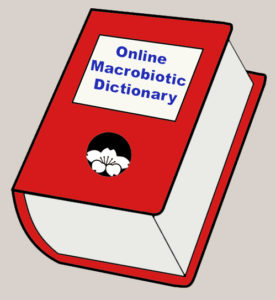
Completed Entries
Protein from vegetal sources is preferred over protein from animal sources in a macrobiotic practice primarily because animal sources are also high in fat. Vegetal protein sources include whole grains eaten with beans; soyfoods like miso, shoyu, tofu, or tempeh; or seitan made from whole wheat for people who tolerate gluten. Other good sources of vegetal protein include nuts and seeds. In very cold places or under conditions of fat-burning activity, some animal protein may be useful for its fat content. Note: textured vegetable protein (TVP) is a factory-made product from a soy protein isolate that results in undesirable by-products and is thus not recommended.
Vegetables are a major source of vitamins and minerals and are a necessary complement to whole grains or other primary food for good health. The macrobiotic recommendation is to eat vegetables daily year-round and to select fresh, locally grown, and seasonal vegetables as often as possible because these are most adapted to one’s local environment. Canned or frozen vegetables are used in cases where fresh vegetables are unavailable—choose the least processed as possible and avoid those with chemical additives or preservatives. Vegetables range from extremely yin to slightly yang. While in the beginning some vegetables were singled out to be avoided completely, current practice for healthy persons is to include all but to be judicious in choosing nightshade vegetables such as potatoes, tomatoes, eggplant, and peppers; vegetables containing large amounts of oxalic acid such as spinach and beet greens; and other extremely yin vegetables as listed. People experiencing a sickness are advised to choose from the slightly yin to slightly yang categories. Note: It is important to remember that each person needs to determine the best foods for his or her condition and purpose.
Here is a list from Essential Guide to Macrobiotics of most vegetables used in macrobiotic practice from extremely yin to slightly yang. Vegetables are listed in approximate yin-to-yang order within each category.
Extremely yin: potatoes, eggplant, tomatoes, shiitake mushrooms, albi, avocados, sweet potatoes, mushrooms, yams, zucchini, yellow summer squash, patty pan squash, bell peppers, artichokes, bamboo shoots, spinach, Swiss chard, asparagus, alfalfa sprouts, okra, Jerusalem artichokes, chives, and Brussels sprouts.
Moderately yin: Chinese cabbage, escarole, kohlrabi, snow peas, green peas, corn on the cob, radishes, string beans, yellow wax beans, purple cabbage, leaf lettuces, endive, cilantro, parsley, bok choy, mustard greens, scallions, collard greens, turnip greens, dandelion greens, beets, broccoli, and cauliflower.
Slightly yin: kale, green cabbage, celery, butternut squash, buttercup squash, Hubbard squash, acorn squash, Hokkaido pumpkin (kabocha), turban squash, leeks, daikon, onions, and watercress.
Slightly yang: turnips, rutabaga, salsify, parsnips, carrots, cress, lotus root, and burdock.
The realization that all foods have a vegetal origin because only vegetables can absorb inorganic elements and convert them into organic foods. Without the vegetal world no animals, including humans, can exist.
The beginning of the organic world and all viruses, bacteria, and vegetables is born from the inorganic world of elements, earth, water, and air. This transition occurs by spontaneous generation. The main characteristic of the vegetal world is that all plants have chlorophyll, making then green. Antagonisms and complementaries include grass and tree, trunk and branch, branch and leaf, flower and seed (or fruit), cell and organ, germ and soma cells. This is the sixth world of the Order of the Universe.
Vegans are persons who eat only vegetal foods. Vegetarians eat primarily vegetables but some include small amounts of animal foods such as fish, eggs, cheese, or other dairy products. Many macrobiotic practitioners are either vegetarian or vegan and the number is growing given the decreasing quality of animal foods.
The beginning of the production of energy and origin of electricity as yin and yang continue to interact with each other and waves such as light and sound waves are created. Antagonisms and complementaries include visible and invisible radiation, hot and cold rays, dynamic and stimulating rays (yellow, orange, red) and static and calming rays (green, blue, indigo, violet), and infrared and ultraviolet radiation. This is the third world of the Order of the Universe.
See Cautionary note.
Ultramicroscopic infectious agents that replicate only within the cells of living hosts. Macrobiotics views viruses as necessary for life and thus not enemies. Viruses are seen as signals that a change to a more healthy diet is needed.
Science separates matter (the visible) and spirit (the invisible) and begins with what is knowable, measurable, and verifiable. Macrobiotics begins with the Infinite that is unknowable, unmeasurable, and beyond sensory verification, uniting matter/body and spirit. “Both ‘visible’ and ‘invisible’ exist, the former measurable in the phenomena of the world we can see, the latter hidden beyond the reach of instruments…The kings of the world of ‘visibility’ are matter, force, and war, while those of the world of ‘invisibility’ are spirit, acceptance, and peace. The goal of the world of ‘visibility’ is relative (satisfaction of desires), while that of the world of ‘invisibility’ is absolute (awareness of Oneness).” Macrobiotic Guidebook for Living, 116 and 118.
Vitamin A is important for cell growth and division and thus in the normal formation and maintenance of all vital organs in the body along with healthy teeth, tissues, mucus membranes, skin, and eyes. Insufficient vitamin A can cause poorly formed cell membranes, liver disorders, and impaired immunity and night vision. Because vitamin A is plentiful in vegetal foods and excess can be stored in the liver, shortages are rare among people eating large amounts of vegetables. Sources of vitamin A include soybeans, carrots, winter squash, rutabagas, other yellow or orange vegetables, broccoli, kale, other green leafy vegetables, and nori.
Vitamin B1 is one of the most important vitamins. It is essential for enabling the body to convert carbohydrates into energy and plays an important role in nerve, muscle, and heart functioning. A serious shortage can cause a loss of appetite, indigestion and possible colitis, inflammation of the heart, and numbness or pain in the fingers or arms. Vegetal sources include whole grains, soybeans and other beans, vegetables, seeds, nuts, and sea vegetables, especially nori and wakame.
Vitamin B2 is another vitamin that plays a vital role in converting foods into energy. A serious shortage can cause reddening of facial skin, cracking at the edges of the mouth, eye soreness, or cataracts. Vegetal sources include whole grains, beans and soy products, broccoli, lettuce, cabbage, turnips, sunflower seeds, nori, and wakame.
Niacin is used by the body to turn food into energy. It helps keep the nervous system, digestive system, and skin healthy. Common signs of a deficiency include inflammation of the skin, fatigue, headache, diarrhea, and memory loss. Vegetal sources include whole grains, beans and soy products, peas, seeds, nuts, shiitake mushrooms, leafy greens, and sea vegetables, especially nori and wakame.
In addition to helping convert food into energy, vitamin B5 is necessary for making blood cells. It is one of the most important vitamins and deficiency is rare. Symptoms include tiredness, insomnia, headache, dizziness, tingling, numbness, irritability, digestive problems, and upper respiratory infections. Vegetal sources include broccoli, kale, and other vegetables in the cabbage family; legumes, especially lentils and soybeans; peanuts; sunflower seeds; mushrooms; avocado; and sweet potatoes.
Vitamin B6 maintains the health of nerves, skin, red blood cells, and brain. It also helps the body make melatonin needed for good sleep. A deficiency can cause nerve problems such as peripheral neuropathy, skin rashes or dermatitis, a weakened immune system, depression, or mood changes. Vegetal sources include whole grains, beans, cabbage, and nuts.
Biotin, also known as vitamin H, helps the body maintain a healthy metabolism and creates important enzymes, especially for processing glucose. It plays a significant role in the health of nails, skin, and hair. Signs of a deficiency include a scaly red rash on the face and in the genital area, lethargy, depression, and numbness or tingling in feet or hands. Vegetal sources include whole grains, cauliflower, mushrooms, sweet potatoes, almonds, walnuts, bananas, and raisins.
Vitamin B9 is known as the growth vitamin because it is important in red blood cell formation and healthy cell growth and function. It is vital during early pregnancy to reduce the risk of birth defects. Symptoms of deficiency include anemia, heart palpitations, headaches, irritability, and shortness of breath. Vegetal sources include dark green leafy vegetables, broccoli, asparagus, beans, peas, nuts, seeds, and many fruits.
Vitamin B12 helps keep blood cells and nerves healthy and helps make DNA in all cells. In macrobiotic thinking, B12 also assists in the transmutation of elements. Symptoms of deficiency include weakness, tiredness, lightheadedness, nerve problems, shortness of breath, constipation, diarrhea, and vision loss. A serious shortage can cause pernicious anemia. Vegans need to be concerned about getting enough of this vitamin because the main sources are animal foods and amounts in vegetal foods are limited. Sources of B12 in macrobiotic practice include sea foods, especially small dried fish (iriko); soy products such as miso, soy sauce, and tempeh; sea vegetables; and bacteria bound to the skins of some organically grown vegetables. In cases of severe shortage, pheasant meat or fowl liver is recommended. Some macrobiotic practitioners take oral vitamin B12 supplements.
Vitamin C is necessary for the growth, development, and repair of all body tissues. It helps the absorption of iron, the immune system, the formation of collagen, and the maintenance of cartilage, bones, and teeth. Signs of a deficiency include, dry damaged skin, easy bruising, painful or swollen joints, and rough skin. A severe deficiency can result in scurvy, which is rare in developed countries because vitamin C is available in so many vegetables and fruits. Vegetal sources include broccoli, parsley, mustard greens, kale, other green leafy vegetables, parsnips, cabbage, carrots, daikon, horseradish, sprouted grains and beans, and fruits, especially strawberries and cantaloupe.
Vitamin D is needed for health and to maintain strong bones and teeth. It also supports the immune system, the brain, the nervous system, lung function, and cardiovascular health. A shortage of vitamin D causes malabsorption of calcium and phosphorous, problems with bone development, and many symptoms from fatigue and muscle pain to autoimmune problems and certain cancers. Exposure to sunlight is the best source of vitamin D. The only vegetal source is mushrooms. Animal sources include fatty fish like salmon and tuna, cheese, and egg yolks. Foods fortified with vitamin D are usually avoided (or limited) in macrobiotic practice unless one has a deficiency and needs to include fortified foods or supplements until an adequate vitamin D value is achieved.
Vitamin E is an antioxidant that helps keep the immune system strong against viruses and bacteria. It’s also important for vision and the health of the brain, blood, and skin. Too little vitamin E can cause an anemic condition and other malfunctions of metabolism. Vegetal sources include whole grains, beans, leafy greens, squash, unrefined vegetable oils, and nuts and seeds.
Vitamin K plays a role in blood clotting, bone metabolism, and regulating blood calcium. A deficiency of vitamin K is responsible for insufficient blood coagulation. Signs include easy bruising, excessive bleeding, and blood in the urine and/or stool. Vegetal sources include whole grains, kale and other green leafy vegetables, cauliflower, broccoli, cabbage, and hijiki.
Vitamins are co-enzymes or catalysts that are essential for the body to work correctly. They perform hundreds of functions from helping the body use the energy in food to bolstering the immune system. There are thirteen essential vitamins; four are fat-soluble (A, D, E, and K) and nine are water-soluble (C and the eight B vitamins). A diet based on whole grains and fresh vegetables contains ample amounts of vitamins, and supplements aren’t needed under normal conditions. If vitamin supplements are taken, ones made from natural sources are recommended—synthetic vitamins are avoided.
The yin or yang characteristics of vitamins can be calculated by the amount of oxygen, nitrogen, and sulfur (all yin) divided by the amount of carbon and hydrogen (both yang). The yin vitamins listed from most yin to slightly yin are C, B2, B12, B3, B1, and B6. The yang vitamins listed from slightly yang to most yang are K, A, E, and D.
Vivere comes from French/Italian and means “to live.” Parvo comes from Latin and means “small.” Ohsawa used the phrase to construct a principle of eating and drinking only what is absolutely necessary. He believed this principle helps one produce an independent life by reducing one’s desires for unnecessary things such as excessive luxury foods and drinks. Ohsawa further believed excesses to be the root of many diseases and that restricting unnecessary foods and drinks helps begin the healing process.
Projected Entries
Valine
Varicosity
Vega Study Center
Vegetable brush
Vegetable stew
Vegetable temple
Venereal disease
Vinegar
Vitality
Vomiting
Von Hufeland, Christophe Wilhelm
Questions or Comments?




